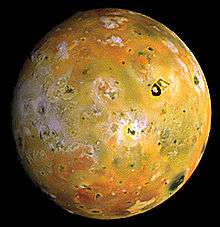Io Volcano Observer
| Operator | Under evaluation by NASA |
|---|---|
| Mission duration |
5-year transit to Jupiter 22-month primary mission at Jupiter |
| Start of mission | |
| Launch date | May 29, 2021 (proposed) |
| Rocket | Atlas V (401)[1] |
| Jupiter orbiter | |
| Orbital insertion | February 2026 (proposed) |
| Orbits | ≥8 |
| Flyby of Io | |
| Closest approach | several proposed dates |
Io Volcano Observer (IVO) is a proposed robotic spacecraft that, if approved and launched, would orbit Jupiter and perform at least nine flybys of Jupiter's moon Io. IVO has been proposed to NASA by the University of Arizona and Johns Hopkins University's Applied Physics Laboratory as a Discovery-class mission in 2010 and 2015.[2][3] IVO is also a contestant for the New Frontiers program.[4] IVO was originally part of NASA's Discovery & Scout Mission Capability Expansion (DSMCE) concept-study program in 2009.[5][6]
IVO is a low-cost, outer-planet mission that would explore Io's active volcanism and impact on the Jupiter system as a whole by measuring its global heat flow, its induced magnetic field, the temperature of its lava, and the composition of its atmosphere, volcanic plumes, and lavas.[1]
Mission profile

IVO's launch would be with an Atlas V (401) rocket. Following launch, the spacecraft would perform an EGA trajectory, using a gravity assist at Earth to send the spacecraft on a trajectory toward Jupiter.[7] Following a flyby of Io on its way in, the Io Volcano Observer would execute a Jupiter orbital insertion burn to go into an inclined orbit around Jupiter. Following an initial six-month orbit, IVO would encounter Io eight times during a 22-month primary mission. As IVO would have an inclined orbit (42°), during each of these encounters it would approach Io from over its south polar region, make its closest approach to Io near its equator between 200 and 500 kilometers, and leave Io over its north polar region.[7] To improve the detection of change, IVO would also encounter Io near the same point in its orbit, keeping similar lighting conditions over the course of the nominal mission.[8] Following the primary mission, if the spacecraft and power source remain intact, an extended mission could be approved. This extended mission could include increasing the orbital period of IVO to one year to monitor Io for changes over a longer time span, and to possibly encounter one of Jupiter's outer irregular satellites. Such an extended mission could last up to eight years, with the potential for up to eight additional encounters.[1]
Current status
Io Volcano Observer (IVO) is a concept under study for NASA's Discovery & Scout Mission Capability Expansion (DSMCE) proposed in 2008, 2009 and 2010 to the Discovery Program,[6] but IVO was not selected. IVO was again proposed in February 2015 for Discovery Mission #13.[9][10] NASA will pick two or more finalists in September 2015 for the second phase of the competition, which will last about one year - the winner will be chosen in September 2016.[11] The selected mission must have a launch readiness by December 31, 2021.[12]
Science
_PIA02308.jpg)
Active volcanism was discovered on Jupiter's moon Io by Voyager 1 in March 1979.[13] This significant amount of volcanism on Io is the result of tidal heating, a process that has also resulted in increased internal heat within other outer planet satellites, such as Enceladus and Europa. On both of these latter moons, the tidal heating has allowed liquid water near the surface of these moons, dramatically affecting their geology and providing a possible habitat for life.[1] Since its discovery in 1979, the volcanic activity on Io was observed by ground-based astronomers as well as the Galileo, Cassini and New Horizons spacecraft. Galileo flew by Io seven times over the course of its nearly-eight-year mission at Jupiter. However, Galileo's low downlink bandwidth resulting from its broken high-gain antenna, camera and spectrometer problems, and safing events that occurred during several of the encounters limited the amount and quality of data that could be returned from these flybys.[14] Both Cassini and New Horizons flew by the Jupiter system at distances greater than the orbit of Callisto, the outermost of the Galilean satellites, limiting the resolution and time span of their data.
Science objectives
The science objectives of this proposed mission are:[2]
- Understand Io's currently active volcanism and implications for volcanic processes on other planetary bodies throughout geologic time.
- Understand Io's interior structure and tidal heating mechanisms and implications for the coupled orbital-thermal evolution of satellites and extrasolar planets.
- Understand the processes that form mountains and paterae on Io and the implications for tectonics under high-heat-flow conditions that may have existed early in the history of other planetary bodies.
- Understand how Io affects the Jovian system, and implications for the study of otherplanetary systems.
- Seek evidence for activity in Io's deep interior and understand the generation of internal magnetic fields.
Scientific payload
The payload includes narrow angle and wide angle cameras, dual fluxgate magnetometers, a thermal mapper, an ion and neutral mass spectrometer, and a plasma ion analyzer.[15] The Principal investigator is Alfred McEwen.
- Narrow-Angle Camera (NAC) 5 μrad/pixel CMOS detector, color imaging in 12 bandpasses from 300-1100 nm, framing images for movies and optical navigation. Filter stripes and filter wheel for color.
- Wide-Angle Camera (WAC) Identical electronics to NAC but with 25° field-of-view for stereo, filter stripes but no filter wheel
- Thermal Mapper (TMAP): 125 μrad/pixel, eight bandpasses for thermal mapping and silicate compositions. The instrument was derived from the Mars Odyssey THEMIS but with an improved microbolometer detector.
- Particle Environment Package for Io (PEPI): Particle science suite that includes the Ion and Neutral Mass Spectrometer (INMS) and the Plasma Ion Analyzer (PIA)
- Dual Fluxgate Magnetometers (DMAG): two units with a sensitivity of 0.01 nT. Contributed by IGEP, Braunschweig.
- Payload Enhancement Options: Student-built Hotspot Mapping Camera (HOTMAP) - Near-infrared bandpasses with the same 25° field-of-view as the WAC.
References
- 1 2 3 4 McEwen, Alfred (August 24, 2009). "Io Volcano Observer (IVO)" (pdf). National Research Council. Retrieved 2010-02-08.
- 1 2 McEwen, A.; et al. (2010). Science Rationale for an Io Volcano Observer (IVO) Mission (PDF). LPSC XLI. Abstract #1433.
- ↑ McEwen, A.; et al. (2015). The Io Volcano Observer (IVO) for Discovery 2015 (PDF). LPSC XLVI. Abstract #1627.
- ↑ Io Volcano Observer (IVO). (PDF), McEwen, University of Arizona. March 2008.
- ↑ Green, James (March 12, 2008). "Planetary Science Update and Lunar Science Plans" (pdf). Goddard Space Flight Center. NASA. Retrieved 2010-02-08.
- 1 2 James L., Green (June 23, 2008). "Planetary Science Division Update" (PDF). NASA. Retrieved 10 November 2009.
- 1 2 McEwen, A.; et al. (2015). "Io Volcano Observer Public Fact Sheet" (PDF).
- ↑ McEwen, Alfred (December 12, 2008). "Io Volcano Observer (IVO)" (pdf). Berkley Io Workshop. Retrieved 2010-02-08.
- ↑ Perry, J. (20 February 2015). "2015 Io Volcano Observer Proposal". The Gish Bar Times.
- ↑ Kane, Van (December 2, 2015). "Selecting the Next Creative Idea for Exploring the Solar System". Planetary Society. Retrieved 2015-02-10.
- ↑ "Small Bodies Dominate NASA's Latest Discovery Competition". SpaceNews.com. July 7, 2015. Retrieved 2015-08-09.
- ↑ "NASA Discovery Program Draft Announcement of Opportunity". NASA Science Mission Directorate. SpaceRef. 2014-02-19.
- ↑ Morabito, L. A.; et al. (1979). "Discovery of currently active extraterrestrial volcanism". Science. 204 (4396): 972. Bibcode:1979Sci...204..972M. doi:10.1126/science.204.4396.972. PMID 17800432.
- ↑ Perry, J.; et al. (2007). "A Summary of the Galileo mission and its observations of Io". In Lopes, R. M. C.; Spencer, J. R. Io after Galileo. Springer-Praxis. pp. 35–59. ISBN 3-540-34681-3.
- ↑ McEwen, Alfred; Elizabeth Turtle; Kenneth Hibbard; Edward Reynolds & Elena Adams (January 2014). "Io Volcano Observer (IVO): Budget travel to the outer Solar System". Acta Astronautica. 93: 539–544. doi:10.1016/j.actaastro.2012.05.028. Retrieved 2014-03-13.


